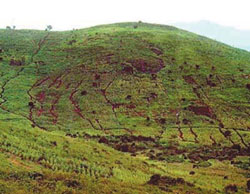You are here » Home » Telling Our Story
|
Malawians adopt sustainable landcare practices increasing harvests and preserving land |
| Millions of Trees and 400,000 Farmers Thriving |
|
|
Malawi has one of the highest population densities in Africa with the majority of people working as smallholder farmers. Deforestation and soil erosion are signs of the great strain on the land. Beginning in 1992, USAID funded The Malawi Agroforestry Extension Project (MAFE) which has trained seventy-seven partner institutions and thousands of communities in sustainable landcare techniques that improve farm productivity. MAFE estimates that farmers are using soil-stabilizing hedges on 21,000 hectares of land, and propagating about twenty million trees annually in tree nurseries.
|

|
Before
With a high population density and an agricultural economy, Malawi faces a terrible strain on its most important natural resource - arable land. This sloping field had been planted with maize continuously with little or no fertilizer, while trees nearby were cut down for firewood or sale. Deep gullies show signs of soil erosion and run-off.
|
| Photo: MAFE |
|
|
After
The shrub Tephrosia, planted among maize, can double a farmer's yield. With proper irrigation using the hand-operated treadle pump, farmers can sow a second harvest during the first season of use. Through these and other landcare techniques, about 400,000 farm families are avoiding hunger with good harvests, and preserving the land. More farms adopt these practices each year with USAID help.
|
 |
Photo: MAFE
|
|
|
Print-friendly version of this page (250kb - PDF)
Back to Top ^
|


